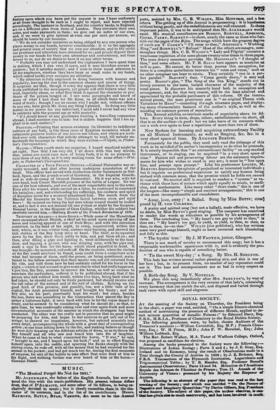ROYAL SOCIETY.
AT the meeting of the Society on Thursday, the President being in the chair, a paper was read, entitled, " On a simple Electro-chemical method of ascertaining the presence of different Metals, applied to de- tect minute quantities of metallic Poisons :" by Edmund Davy, Esq. F.R.S., M.R.LA., Professor of Chemistry to the Royal Dublin Society-.
The following gentlemen were, by ballot, chosen Auditors of the TreaSurer's accounts :—William Cavendish, Esq. M.P.; Francis Chan. trey, Esq.; W. H. Fitton, M.D.; John F. W. Herschel, Esq; John
William Lubbock, Esq. it The Rev. Robert Walker, M.A. Tutor of Wadham College, Oxford, was proposed as candidate for election.
Among the books presented to the Society were the following:-- Illustrations of Indian Zoology ; Parts 3 and 4:; by J. E. Gray, Esq. Ireland and its Economy, being the result of Observations made in as Tour through the County of Antrim in 1829 ; by J. E. Bicheno, Esq. Transactions of the Plymouth Institution. Logarithmic and Trigonometrical Tables ; by T. R. Hassler, Esq. Professor Besse's, Astronomical Observations; Farts 13 and 14. Memoires de FAcademie Royale des, Sciences de Plustitut de France; Tom. II. Annals of the University of Vienna - presented by his Majesty the Emperor of Austria.
The following is an abstract of the paper that was read at the last meeting of the Society ; and which was entitled " On the Nature of Negative and losaginary Quantities :" by Davies Gilbert, Esq. President of the Society The subject of this paper, the author observes, is one that has givensiee to much controversy, and has been.invelved in much. unnecessary mystery. Paradoxes and apparent solecisms, when involved with facts and indubitable truths, will always be found, upon accurate ex- amination, to lie near the surface, or to owe their existence either to am- biguity of expression, or to the unperceivettadoptions of some extraneous additions or limitations into the compound terms employed for definition, and which are subsequently taken as constituent parts of their essence. The. first misapprehension pointed out, is that of considering any quan- tity whatever as negative per se, and without reference to another opposed to it, which has previously been established as positive. • In order to avoid previously-formed associations of ideas, the author prefers employ- ing, in his reasonings on thiS subject, the symbols (a) and (b) to express this quality of opposition, rather than the usual ones of plus and minus. By the aid of this notation, he is enabled to present, in its full generali- zation, the law of the signs in multiplication—a process which, it is well known, is founded solely upon the principle of ratios ; and to show that like signs invariably give the sign belonging to the assumed unity, or universal antecedent of the ratios, and unlike signs the contrary. Since either the one or the other of the arithmetical scales derived from the two unities is, in itself, equally affirmative, but negative with relation to the other, it follows that, by using the scale of (b), all even roots in the scale of (a) will become imaginary, and thus the apparent discrimination of the two scales is removed : so that the pro- perties belonging to the two scales are interchangeable, and all formulae become universally applicable to both, by changing the signs according to the side in which the antecedent is taken. Imaginary quantities, then, are merely creations of arbitrary definitions, endow; ed with properties at the pleasure of him who defines them ; and the whole dispute respecting their essence turns upon the very point that has been contested from the earliest times between the hostile sects of Realists and Nominalists. It is now, however, universally agreed, that all abstrac- tions and generalizations are mere creatures of the reasoning faculty, ex- isting no where but in the mind contemplating them. Such, in algebra, are the supposed even roots of a real quantity, taken in the scale opposite to that which has given the universal antecedent : the sign indicating the extraction impossible to be performed, veils the real quantity, and renders it of no actual value, until the sign is taken away by an involu- tion, the reverse of the supposed operation which the sign represents ; although the quantity itself is, in the meantime,, by its arbitrary essence made applicable to all the purposes for which real quantities are used in every kind of formula. Several illustrations of these views of the nature of imaginary quantities occurring in logarithmic formulae, and series ex- pressing circular arcs, are given by the author. By considering all quan- tity as affirmative per se, and admitting plus and minus merely as corre- lative terms, we thus succeed in banishing mystery and paradox from the science most powerful in eliciting truth, and where they ought least to find a place.



























 Previous page
Previous page